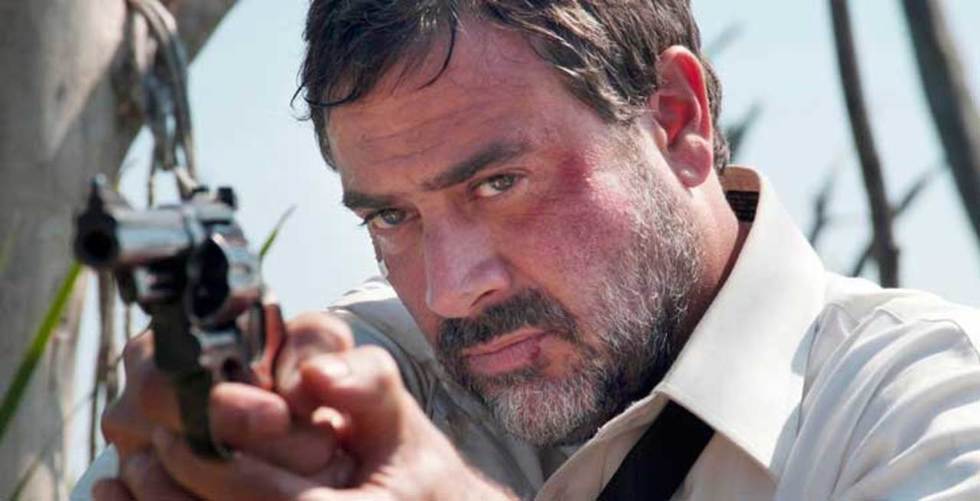
BY ZACHARY WIGON |
Texas Killing Fields: A Hunt For Evil
Director Ami Mann invites us into the desolate gulf fields to experience a terror that is all too real.


Photo Credit: Gusmano Cesaretti, Property of Anchor Bay Films
When someone refers to “the killing fields,” it’s usually assumed that one is referring to the brutal Khmer Rouge regime in Cambodia, and perhaps the Roland Joffe film that bears that title. With her second feature film, Texas Killing Fields, Ami Mann (daughter of Michael) has brought to light the other killing fields — a breathtakingly creepy, eerily beautiful area by the Gulf Coast in Texas where bodies have been turning up since the 60's. Mann, who has worked in television as well, eschews a basic procedural approach to her story of a serial killer on the loose in Texas City, Texas, for a more lyrical, sensuous presentation of her storyline.
Mann certainly isn’t at a loss as far as her cast is concerned – with Sam Worthington and Jessica Chastain as Texas detectives tracking a serial killer of young women, and Chloe Moretz as a young woman who seems destined to become another victim, she has a team that instills a fresh sense of urgency in the detective/serial killer sub-genre. The film was inspired by true events, and a close attention to detail which stems from a respect for the murders upon which the film is based is apparent, grounding the film in a stark realism. I had the chance to speak with Mann recently about how her film came together.

Photo Credit: Gusmano Cesaretti, Property of Anchor Bay Films
Tribeca: I wanted to ask you first off about the visuals of the killing fields. How did you scout the location? Can you tell me about capturing the essence of the area visually?
Ami Mann: I spent some time in Texas City going to the crime scenes. Texas City is about 30 minutes south of Houston, it’s a pretty small town. What you see is wall-to-wall refineries, you can’t see the gulf. Outside the city is this area where all these bodies have been found, and that’s known to the locals as the killing fields. I went to where these two prostitutes had been murdered, and the thing that really struck me about being out there was that there was nothing really visually significant about the actual killing fields. It was kind of flat scrub brush. But I understood why if you were a killer, you would take people there. It’s right along the freeway, the interstate, but if you were to scream, no one would hear you. If you were to run, there’s no place to go. You’re out in the open, but hidden at the same time. My sister, who’s a production designer, and I went to Lousiana to scout locations. While they are different states, they’re both along the gulf, so the terrain is really similar. The water wraps above the land in a very particular way. The architecture is similar. Culturally, there’s a kind of Gulf culture. So when we were in Louisiana doing location scouting, we turned onto this road and came across this forest of what looked like petrified trees. I’d never seen anything like it. I knew right away that had to be the killing fields. It had this quality I wanted to bring into the story. I wanted it to feel almost like a ghost story, with the visuals and the music. Less a TV, episodic thing, less a graphic horror movie. I thought, because it was inspired by real events, the best way to approach it was to be sensorily evocative, and these trees had that quality of being hard to look at, but you can’t stop looking at them. I learned later that these weird forests are all along the coasts.
Tribeca: What was the phrase you used? Petrified trees?
Ami Mann: Yes. One hundred years ago they were actually forests, but global warming has caused the water tables to rise. Salt water has slowly seeped up through the roots and killed the trees from the inside out. You feel like what you’re looking at is not quite right, when you look at those trees.

Photo Credit: Gusmano Cesaretti, Property of Anchor Bay Films
Tribeca: You mentioned you wanted to go for a more evocative tone, like a ghost story. There are scenes where the suspense comes from a kind of minimalism, or simplicity. Can you tell me about your approach to suspense filmmaking?
Ami Mann: I guess there are different ways to have suspense, right? I grew up in a small town in Indiana, and Indiana is really flat. There’s something scary about that, to me – endless horizon. Where you get the sense that you could just walk and walk and walk and never get out of this place. So in certain scenes, like where Chloe Moretz is walking alone, I wanted you to feel like the horizon line had no end. That she’s unsure of where she is, if she’ll ever get out. The attempted rape scene is about the familiarity of domesticity. You’re 22 years old, you’re looking after your kid, you go to bed in a big old t-shirt. There’s a familiarity to it, like brushing your teeth. Within the familiarity, the bad thing arrives. I guess that’s a different kind of suspense.
Tribeca: The horror that can arise from a comfortable setting.
Ami Mann: Yeah. That was actually based on a real event, and the woman who was the victim was on set when we were shooting. It was important to me that she respond as I would like to think that I would’ve responded – that she would fight.
Tribeca: That scene was particularly terrifying. Something about the jacket that the rapist wears – the camo jacket – really seemed to be particularly unnerving.
Ami Mann: That’s called a ghillie suit. The mosquitoes are so intense down in that part of the country that hunters wear that to protect themselves. I saw a grip wearing one early in the shoot and I said, that’s it! It’s a scary-looking suit. You can’t really tell, but he’s not wearing any clothes underneath it. You can feel, a bit, the flesh on his back. Normally you wear clothes underneath it. There’s something about feeling the flesh underneath it that’s a little disconcerting.
Tribeca: What was it like, to have the victim on set during the scene? Did it change the tenor of the scene?
Ami Mann: I felt very honored that she was there. She’s an incredibly smart, tough woman. It was great to have her there as a reference, for the actors to be able to talk to her. It might have changed the tenor, but only in the most positive way. The idea for that scene, and the entirety of the film, was to reach for as much authenticity as possible. The characters were based on or inspired by real people.
Tribeca: You have the card in the beginning – inspired by true events. Can you tell me a bit about moving from researching these murders into fashioning a fiction film?
Ami Mann: The story was written by Don Ferrarone, who had worked with Michael doing some previous research when he was in the DEA and had decided to become a screenwriter. Michael commissioned this. That was some eleven years ago. When it fell to me, I felt really lucky that there was so much reality to draw from, so many paths of research I could traverse. What I thought was so clever about his approach to the material was that, in fact, there are fifty some-odd murders that have occurred in this area since 1969. One thing that I liked about his approach was that he focused on these two detectives in Texas City. When I sat down and spoke with him, one of the first things I spoke about was the idea of elevating the character of Little Anne, so it was almost this troika of the two men and this girl, and that she could become almost a conduit, a metaphor for the past victims and, unfortunately, potential victims in the future.
Texas Killing Fields is now playing. Find tickets.